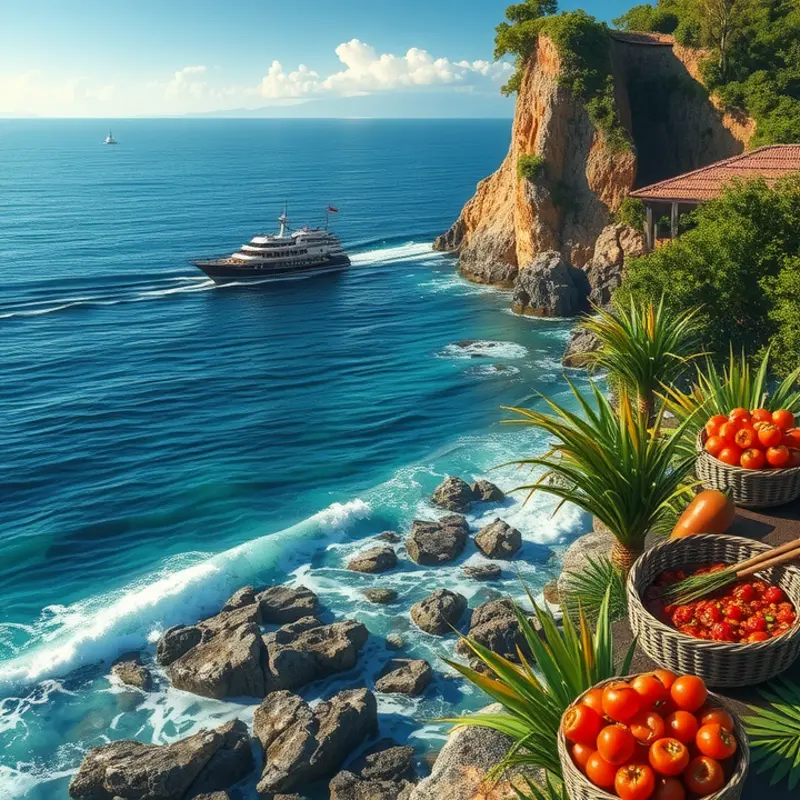Seafood is more than just a meal; it represents cultural traditions, local environments, and culinary artistry. Across the globe, unique seafood dishes tell stories of their regions, from fresh catch preparations to historic recipes. This exploration delves into the culinary treasures of the sea, highlighting vibrant flavors and cooking styles that will tantalize curious tastes and inspire adventurous palates.
Savoring the Sea: South American Delicacies

From the sun-drenched coastline of Peru to Brazil’s lively beaches, South America is a haven for seafood aficionados. Here, culinary traditions steeped in history and vibrant flavors come to life through dishes like Ceviche and Moqueca.
Ceviche represents more than a mere meal in Peru; it is an emblem of the country’s rich cultural heritage. The dish, typically made from raw fish marinated in freshly squeezed lime juice, combines simplicity with complexity. The citric acid from the limes “cooks” the fish, transforming its texture and infusing it with a refreshing zest. The addition of thinly sliced red onions, spicy chili peppers, and a sprinkle of chopped cilantro add layers of flavor and color, making Ceviche a sensory delight.
The origins of Ceviche are as intriguing as its taste. It is believed to have been influenced by ancient Andean civilizations, evolving over centuries to become a staple in Peruvian cuisine. Some culinary historians trace its roots back to the Moorish occupation of Spain, which subsequently found its way to Peru through colonization. While lime and the use of raw fish are the dish’s defining elements, regional variations abound. For instance, in northern Peru, it’s common to add cancha, or roasted corn, for extra texture.
Moving east, the Brazilian coastline offers Moqueca—a seafood stew bursting with character. Moqueca blends indigenous, African, and Portuguese culinary techniques, reflecting the country’s diverse cultural fabric. Traditionally made in a clay pot, the dish features fish or shrimp simmered in coconut milk, a medley of bell peppers, tomatoes, and onions. What sets the Brazilian version apart is the use of dendê oil, derived from palm fruit, imparting a deep, rich flavor and vibrant color.
The beauty of Moqueca lies not only in its taste but also in its adaptability. In the north, particularly in Bahia, dendê oil plays a crucial role, tying the dish to its African influences. In contrast, the southeastern variant, known as Moqueca Capixaba, shuns dendê oil and emphasizes the use of olive oil and annatto seeds, demonstrating how regional preferences shape the culinary landscape.
Understanding the indigenous and regional roots of these dishes enriches our appreciation and culinary adventure through South America. These seafood delicacies remind us of the cultural confluence that influences global gastronomy. For those seeking to further explore their seafood journey, consider speedy seafood prep techniques to enhance the experience of savoring these exquisite dishes.
Whether enjoying the tangy freshness of Ceviche or the aromatic warmth of Moqueca, South America’s seafood offerings promise a rewarding tasting experience. These dishes are not just about satisfying hunger—they are an invitation to explore a vibrant culinary history, where every bite tells a story.
A Taste of the East: Asian Seafood Wonders

Asia’s culinary landscape is famed for its bold and intricate flavors, and seafood is a staple ingredient that highlights this richness. Two dishes capturing this are the Japanese Sashimi and Sushi, and the Thai Yum Talay. Beginning with Japan, a country where the artistry and philosophy of food manifest vividly, Sashimi and Sushi stand as cultural ambassadors. These delicacies are not merely about consuming fish but engage diners in a ritual of fine dining.
Sashimi emphasizes the unmatched importance of freshness. Fresh fish slices are meticulously prepared; each cut is deliberate, guided by an age-old tradition of precision. Sushi elevates this further by balancing vinegared rice with the fish, enriching the palate without overshadowing the natural taste of the sea. Here, presentation isn’t just about appearance—it’s a mindfulness practice, demanding respect for the seasonal ingredients and a keen appreciation of their innate flavors.
Traveling south to Thailand, the culinary approach shifts from sophisticated precision to a vibrant explosion of flavors. Yum Talay, a fiery seafood salad, epitomizes this transformation. The name ‘Yum’ refers to the salad’s seasoned blend, while ‘Talay’ represents the ocean’s bounty. Each bite is a symphony of sour, sweet, salty, and spicy notes—an alchemical combination of lime juice, fish sauce, garlic, chilies, and fresh herbs like mint and coriander. This dish is proof of Thailand’s skill in balancing intense flavors while maintaining harmony.
An intriguing aspect of Yum Talay is its adaptability. Whether indulging in plump shrimp, tender squid, or succulent mussels, the core ingredient can be adjusted to fit what’s fresh and available, aligning with sustainable eating practices important for mindful consumption and global culinary integrity. For those interested in minimizing preparation time without losing flavor complexity, you might explore some speedy seafood preparations here.
Both Japanese and Thai seafood dishes offer more than just sustenance—they are experiences where each ingredient plays a critical role. These dishes are conduits through which culture and tradition are not only tasted but felt. This deep appreciation extends beyond the meal itself into an ongoing celebration of heritage, showcasing seafood as both a daily staple and a venerable feast.
From the delicate balance of flavors in Sushi to the sensory dance of ingredients in Yum Talay, Asian seafood illuminates the diverse applications of oceanic ingredients across cultures. As these dishes make their way to tables around the world, they remind us of the importance of technique, tradition, and sustainability in seafood preparation.
Final words
The world of seafood is a vibrant and diverse culinary playground filled with unique dishes that reflect cultural histories and regional ingredients. Whether indulging in the zesty and refreshing tastes of South America’s ceviche or savoring the delicate artistry of Japanese sushi, each seafood dish transports us to its origin, enriching our understanding of global cuisine. For food enthusiasts, diving into these diverse traditions not only broadens the palate but also deepens appreciation for the intricate relationships between culture and cuisine. As you embark on your own culinary explorations, remember that every bite tells a story—so savor each moment.








